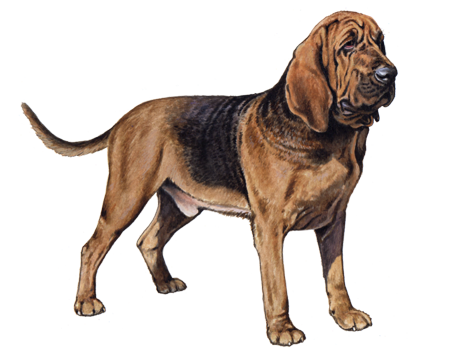
Spanish Hound
Ancestors of the Spanish Hound have been Iberian hunters’ best friends since at least the Middle Ages. This calm, courageous breed has a keen sense of smell and an affectionate personality, and is known for its distinctive voice changes when on the hunt.
Interested in discovering if your dog is a Spanish Hound?
Check out Wisdom Panel's DNA tests.

Spanish Hound Traits
General Appearance
This medium-sized breed has a rectangular body, strong limbs, and a sweet, sad expression.
Coat and Colouring
The Spanish Hound's coat is dense, short, and smooth. Its loose skin sometimes forms adorable wrinkles on the forehead when the head lowers. The breed's coat is white and orange (red) with irregular patches, but little ticking. The orange color ranges from lemon to dark russet brown.
Distinctive Physical Traits
Notable traits of the Spanish Hound include a long head, long hanging ears, a well-developed chest, powerful legs, and a tail with short hairs that form a small paintbrush at the tip.
Spanish Hound Temperament
The Spanish Hound is brave and tenacious while hunting and calm and affectionate at home. They love being outside and are well-suited for active families with plenty of safe spaces to explore. Because they often hunt in small groups, they typically get along with other dogs.
Like other scent hounds, they are prone to wandering off if they pick up an irresistible smell. For this reason, it's best to keep them on a leash or in an enclosed area.
Spanish Hound History
The Spanish Hound, or Sabueso Español, originated long ago in Iberia, but beyond that, the details are lost to time. In comparison to other countries like France and England, documentation of the origins and history of Spanish breeds is poor, but there appears to have been an active scent hound hunting culture by the 3rd century in Roman Hispania, leading some to think the breed descended from Gallic hounds.
King Alfonso XI, called the “hunting king,” first documented what is believed to be the Spanish hound in the manuscript Libro de la Montería in the 14th century. The breed is best known as a hare and wild boar hound, though it was used to hunt larger game like bears and wolves in the past when large game was abundant. The Spanish Hound was one of the first to be recognized by the newly formed Real Sociedad Canina de España (RSCE), or Spanish Kennel Club, in 1911. Only 12 dogs were registered in the following 25 years, and after the Spanish Civil War and World Wars, the breed was thought to be extinct. However, a few survived thanks to the work of dedicated breeders, particularly Antonio Miján, who preserved the breed during the fad of French hounds in the 60’s and 70’s.
In 1977, the Club de Sabueseros de España (the Spanish Houndsman Club) was formed, followed in 1985 by the Club del Sabueso Español y Razas Afines, which promotes the breed to this day. The breed was recognized by the FCI in 1982.
Spanish Hound Care
Nutrition
This breed thrives on high-quality dog food appropriate for their age, size, and activity level. To help them maintain a healthy weight, measure their meals to avoid overfeeding and keep treats to 10% or less of their daily calories.
Grooming
The Spanish Hound's short coat requires regular brushing to remove loose fur and dirt. Because their long pendant ears may make it harder to spot ear infections, it's important to check their ears regularly and clean them if you see any wax build-up or debris. Additionally, nail trims and dental care should be part of their grooming routine.
Exercise
Spanish Hounds need daily exercise for their physical and mental health. Hunting is their preferred activity, but any outdoor activity will do. Brisk walks, hikes, and scent-tracking games that let them show off their instincts are great ways to keep them happy and healthy.
Training
Spanish Hounds are intelligent dogs that respond well to consistent training using positive reinforcement techniques. Additionally, all dogs benefit from early socialization. Helping them feel comfortable with different people and environments when they're young will help them grow into well-adjusted adult dogs.
Breed Group
Hound
The most common ancestral trait of this group is being used for hunting. Some use acute powers of scent to follow a trail while others demonstrate the gift of stamina as they run down a quarry. Beyond these two common traits, however, generalizations about hounds are hard to come by as the group is comprised of a very diverse lot of breeds.












































